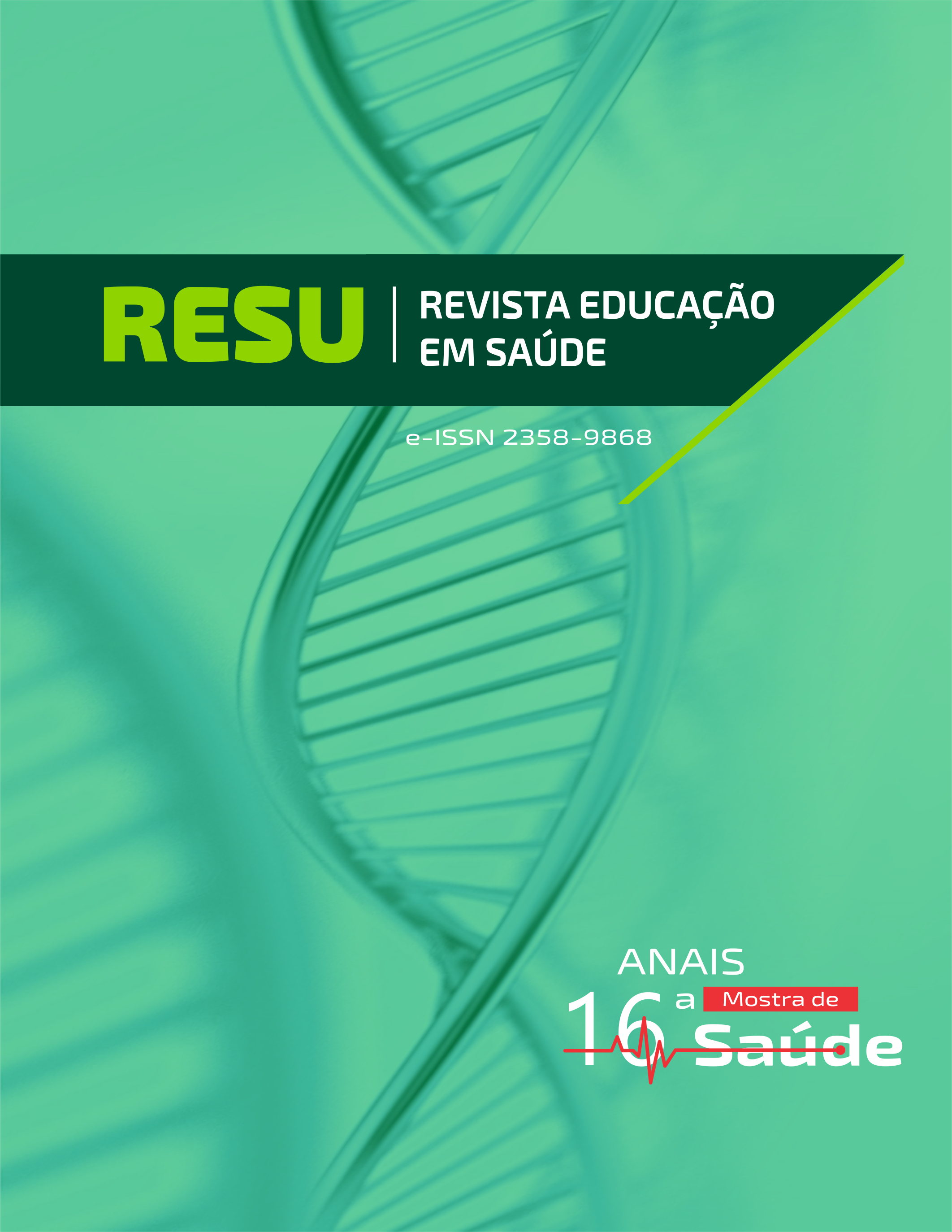Diagnóstico Diferencial do Transtorno do Espectro Autista (TEA)
Palavras-chave:
Transtorno do Espectro Autista, Diagnóstico, Diagnóstico diferencialResumo
O transtorno do espectro autista (TEA) refere se a um atraso de neurodesenvolvimento caracterizado por déficits clinicamente significativos e persistentes na comunicação e nas interações sociais, bem como por padrões restritos e repentinos de interesse, comp ortamento e atividades . O presente trabalho tem por objetivo descrever os principais métodos de diagnóstico diferencial do TEA estabelecendo assim condutas amplas e precisas no diagnóstico deste transtorno Trata se de uma revisão integrativa de artigos col etados em plataformas do Public Medline (PubMed), Scientific Eletronic Library Online (Scielo), com a pesquisa dos descritores “Autism”, “Autism Diagnosis” e “Autism Comorbidities’’. Foram utilizados 20 artigos, nas línguas inglesa e portuguesa, com os ano s de publicação entre 2015 e 2019, com exceção de um artigo base publicado em 2000. Encontrou se como padrão ouro de diagnóstico diferencial de TEA, os métodos “The Autism Diagnostic Observation Schedule (ADOS)” e o “Autism Diagnostic Interview Revised (AD I R) in Clinical Settings”. Além desses, foram selecionados outros métodos, os quais também apresentaram alta eficiência diagnóstica: Autism Detection in Early Childhood (ADEC), Espectroscopia no Infravermelho Próximo, Teste do Gene Receptor de Ocitocina e o teste do miRNA.Conclui se que os métodos ADI R e o ADOS são os métodos de diagnóstico diferencial padrão ouro e, portanto, faz se necessária uma correlação entre ambos para se garantir uma conduta precisa e eficaz, bem como a importância de um diagnósti co precoce associado à aplicação desses testes, visando um melhor prognóstico para o paciente com TEA.
Referências
BIELENINIK, L; POSSERUD, M-B; GERETSEGGER, M; THOMPSON, G; ELEFANT, C; GOLD, C. Tracing the temporal stability of autism spectrum diagnosis and severity as measured by the Autism Diagnostic Observation Schedule: A systematic review and meta-analysis. Plos One. v.12, n.9, p: 2017.
FERNANDES, C; FICHMAN, H; BARROS, P. Evidência de diagnóstico diferencial entre Transtorno do Espectro Autista (TEA) e Transtorno do desenvolvimento intelectual (TDI): análise de casos. Neuropsicologia Latinoamericana. v.10, n.2, p:29-41, 2018.
FUSAR-POLI, L et al. Diagnosing ASD in adults without ID: accuracy of the ADOS-2 and the ADI-R. Journal of autism and developmental disorders. v. 47, n.11, p: 3370-3379, 2017.
GENG, Y et al. Oxytocin Enhancement of Emotional Empathy: Generalization Across Cultures and Effects on Amygdala Activity. Frontiers in Neuroscience. V. 12, n 512, 2018.
GONÇALVES, D; GUARDIANO, M; LEÃO, M. Investigação Etiológica da Pertubação do Espectro do Autismo – o Estado da Arte. Nascer e Crescer. v.27, n.4, p:1-6, 2018.
GULATI, S et al. Development and validation of DSM-5 based diagnostic for children with Autism Spectrum Disorder. Plos One. v.14, n.3, p:1-11, 2019.
HANSEN, RL; BLUM, NJ; GAHAM, A; SHULTS, J. Diagnosis of Autism Spectrum Disorder by Developmental-Behavioral Pediatricians in Academic Centers: A DBPNet Study. PEDIATRICS. v.137, n.S2, 2016.
HEDLEY, D et al. Efficacy of the ADEC in Identifying Autism Spectrum Disorder in Clinically Referred Toddlers in the US. J Autism Dev Disord. v. 45, n. 1, p:2337-2348, 2015.
HICKS, SD et al. Saliva microRNA Differentiates Children with Autism from Peers with Typical and Atypical Development. Journal of the American Academy of Child and Adolescent Psychiatry. v.19, 2019.
KAMP-BECKER, I et al. Diagnostic accuracy of the ADOS and ADOS-2 in clinical practice. European Child & Adolescent Psychiatry. v.27, n.9, p: 1193-1207, 2018.
KANG, E; GADOW, KD; LERNER, MD. Atypical Communication Characteristics, Differential Diagnosis and the Autism Spectrum Disorder Phenotype in Youth. Journal of Clinical Child & Adolescent Psychology. v.1, n.13, 2019.
KILROY, E; CERMAK, S A; AZIZ-ZADEH, L; A Review of Functional and Structural Neurobiology of the Action Observation Network in Autism Spectrum Disorder and Developmental Coordination Disorder. Brain Sci. v.9, n.4, p:1-27, 2019.
LORD, C et al. The Autism Diagnostic Observation Schedule-Generic: A Standard Measure of Social and Communication Deficits Associated with Spectrum of Autism. Journal of Austism ond Developmental Disorders. v.30, n.3, p:205-223, 2000.
NAH YH; YOUNG R; BREWER N; GENNA B. Autism Detection in Early Childhood (ADEC): Reliability and Validity Data for a Level 2 Screening Tool for Autistic Disorder. Psychologieal Assessment. v. 26, n. 1, p: 215-226, 2014.
SEIZE, M; BORSA, J. Instrumentos para Rastreamento de Sinais Precoces do Autismo: Revisão Sistemática. Psico – USF. v. 22, n. 1, p:161-176, 2017.
SIMMS, MD. When Autistic Behavior Suggests a Disease Other than Classic Autism. Pediatr Clin N Am. v. 64, n. 1, p: 127–138, 2017.
UZEFOVSKY, F et al. The oxytocin receptor gene predicts brain activity during an emotion recognition task in autism. Molecular Autism. v.10, n.12,2019.
VANEGAS, SB et al. Clinical Validity of the ADI-R in a US-Based Latino Population. J Autism Dev Disord. v. 46, n.1, p: 1623–1635, 2016.
VATS, P; JUNEJA, M; MISHRA D. Diagnostic Accuracy of International Epidemiology Network (INCLEN) Diagnostic Tool for Autism Spectrum Disorder (INDT-ASD) in Comparison with Diagnostic and Statistical Manual of Mental Disorders-5 (DSM-5). Indian Pediatrics. v.55, n.6, p: 482-484, 2018.
YANAGISAWA, K; NAKAMURA, N; TSUNASHIMA, H; NATURA, N. Proposal of auxiliary diagnosis index for autism spectrum disorder using near-infrared spectroscopy. Neurophotonics. v.3, n.3, 2016.
YEUNG, M K; LEE, T L; CHAN, A S. Frontal lobe dysfunction underlies the differential word retrieval impairment in adolescents with high-functioning autism. International Society for Autism Research. v.12, n.4, p:537-693, 2019.
ZANDER, E et al. The Interrater Reliability of the Autism Diagnostic Interview-Revised (ADI-R) in Clinical Settings. Psychopathology. v. 50, n. 1, p: 219–227, 2017
ZANDER, E et al. The objectivity of the Autism Diagnostic Observation Schedule (ADOS) in naturalistic clinical settings. Eur Child Adolesc Psychiatry. v.25, n.1, p: 769–780, 2016.
ZUANETTI, P; SILVA, K; FERNANDES, A C; DORNELAS, R; FUKUDA, M. Características da prosódia emissiva de crianças com transtorno do espectro autista. CEFAC. v.20, n.5, p:565-572, 2018.


